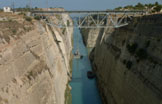|

Corinth
Canal
The Corinth
Canal links the Gulf of Corinth in the northwest with
the Saronic Gulf in the southeast. The canal is 3.9 miles
(6.3 km) long and has a water depth of 26 feet (8 m). Its
width varies from a minimum of 69 feet (21 m) at the bottom
to 82 feet (25 m) maximum at the water's surface.
Before it was built, ships sailing between the Aegean and
Adriatic had to circumnavigate the Peloponnese adding about
185 nautical miles to their journey. The first to decide to
dig the Corinth Canal was Periander, the tyrant of Corinth
(602 BCE). Such a giant project was above the technical
capabilities of ancient times so Periander carried out
another great project, the diolkós, a stone road, on
which the ships were transferred on wheeled platforms from
one sea to the other. Dimitrios Poliorkitis, king of Macedon
(c. 300 BCE), was the second who tried, but his
engineers insisted that if the seas where connected, the
more northerly Adriatic, mistakenly thought to be higher,
would flood the more southern Aegean. At the time, it was
also thought that Poseidon, god of the sea, opposed joining
the Aegean and the Adriatic. The same fear also stopped
Julius Caesar and emperors Hadrian and Caligula. The most
serious try was that of Emperor Nero (67 CE). He had 6,000
slaves for the job. He started the work himself, digging
with a golden hoe, while music was played. However, he was
killed before the work could be completed.
In the modern era, the first who thought seriously to carry
out the project was Capodistrias (c. 1830), first
governor of Greece after the liberation from the Ottoman
Turks. But the budget, estimated at 40 million French
francs, was too much for the Greek state. Finally, in 1869,
the Parliament authorized the Government to grant a private
company (Austrian General Etiene Tyrr) the privilege to
construct the Canal of Corinth. Work began on Mar 29, 1882,
but Tyrr's capital of 30 million francs proved to be
insufficient. The work was restarted in 1890, by a new Greek
company (Andreas Syggros), with a capital of 5 million
francs. The job was finally completed and regular use of the
Canal started on Oct 28, 1893.
Click on the thumbnails below in order to see pictures of the Corinth Canal. Use your browser's back button
to return to this page.

|
|
|
|
|
|
 The
Corinth Canal with the road bridge overhead. There is a ship at the
distant entrance. The
Corinth Canal with the road bridge overhead. There is a ship at the
distant entrance.
|
|
 The
Corinth Canal The
Corinth Canal
|
|
|
|
|
|
|
|
© All pictures are Copyright 2000 Grisel Gonzalez and Jeff
Prosise
|